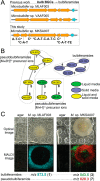Pseudobulbiferamides: Plasmid-Encoded Ureidopeptide Natural Products with Biosynthetic Gene Clusters Shared Among Marine Bacteria of Different Genera
- PMID: 37713418
- PMCID: PMC10616845
- DOI: 10.1021/acs.jnatprod.3c00595
Pseudobulbiferamides: Plasmid-Encoded Ureidopeptide Natural Products with Biosynthetic Gene Clusters Shared Among Marine Bacteria of Different Genera
Abstract
Ureidopeptidic natural products possess a wide variety of favorable pharmacological properties. In addition, they have been shown to mediate core physiological functions in producer bacteria. Here, we report that similar ureidopeptidic natural products with conserved biosynthetic gene clusters are produced by different bacterial genera that coinhabit marine invertebrate microbiomes. We demonstrate that a Microbulbifer strain isolated from a marine sponge can produce two different classes of ureidopeptide natural products encoded by two different biosynthetic gene clusters that are positioned on the bacterial chromosome and on a plasmid. The plasmid encoded ureidopeptide natural products, which we term the pseudobulbiferamides (5-8), resemble the ureidopeptide natural products produced by Pseudovibrio, a different marine bacterial genus that is likewise present in marine sponge commensal microbiomes. Using imaging mass spectrometry, we find that the two classes of Microbulbifer-derived ureidopeptides occupy different physical spaces relative to the bacterial colony, perhaps implying different roles for these two compound classes in Microbulbifer physiology and environmental interactions.
Conflict of interest statement
The authors declare no competing financial interest.
Figures



Similar articles
-
Polymer degrading marine Microbulbifer bacteria: an un(der)utilized source of chemical and biocatalytic novelty.Beilstein J Org Chem. 2024 Jul 17;20:1635-1651. doi: 10.3762/bjoc.20.146. eCollection 2024. Beilstein J Org Chem. 2024. PMID: 39076296 Free PMC article. Review.
-
Discovery and Biosynthesis of Ureidopeptide Natural Products Macrocyclized via Indole N-acylation in Marine Microbulbifer spp. Bacteria.Chembiochem. 2023 Jun 15;24(12):e202300190. doi: 10.1002/cbic.202300190. Epub 2023 May 11. Chembiochem. 2023. PMID: 37092875
-
An Obligate Peptidyl Brominase Underlies the Discovery of Highly Distributed Biosynthetic Gene Clusters in Marine Sponge Microbiomes.J Am Chem Soc. 2021 Jul 14;143(27):10221-10231. doi: 10.1021/jacs.1c03474. Epub 2021 Jul 2. J Am Chem Soc. 2021. PMID: 34213321 Free PMC article.
-
Comparative Metagenomic Analysis of Biosynthetic Diversity across Sponge Microbiomes Highlights Metabolic Novelty, Conservation, and Diversification.mSystems. 2022 Aug 30;7(4):e0035722. doi: 10.1128/msystems.00357-22. Epub 2022 Jul 18. mSystems. 2022. PMID: 35862823 Free PMC article. Review.
-
Highlights of marine natural products having parallel scaffolds found from marine-derived bacteria, sponges, and tunicates.J Antibiot (Tokyo). 2020 Aug;73(8):504-525. doi: 10.1038/s41429-020-0330-5. Epub 2020 Jun 8. J Antibiot (Tokyo). 2020. PMID: 32507851 Free PMC article. Review.
Cited by
-
Pseudovibriamides from Pseudovibrio marine sponge bacteria promote flagellar motility via transcriptional modulation.mBio. 2025 Feb 5;16(2):e0311524. doi: 10.1128/mbio.03115-24. Epub 2024 Dec 27. mBio. 2025. PMID: 39727420 Free PMC article.
-
Polymer degrading marine Microbulbifer bacteria: an un(der)utilized source of chemical and biocatalytic novelty.Beilstein J Org Chem. 2024 Jul 17;20:1635-1651. doi: 10.3762/bjoc.20.146. eCollection 2024. Beilstein J Org Chem. 2024. PMID: 39076296 Free PMC article. Review.
-
Pyrrolidine, Piperazine, and Diazinane Alkaloids from the Marine Bacterium Strain Vibrio ruber ZXR-93.Molecules. 2024 Sep 19;29(18):4446. doi: 10.3390/molecules29184446. Molecules. 2024. PMID: 39339441 Free PMC article.
-
Discovery of Peptidic Siderophore Degradation by Screening Natural Product Profiles in Marine-Derived Bacterial Mono- and Cocultures.Biochemistry. 2025 Feb 4;64(3):634-654. doi: 10.1021/acs.biochem.4c00706. Epub 2025 Jan 14. Biochemistry. 2025. PMID: 39807563 Free PMC article.
References
-
- Becher P. G.; Verschut V.; Bibb M. J.; Bush M. J.; Molnár B. P.; Barane E.; Al-Bassam M. M.; Chandra G.; Song L.; Challis G. L.; Buttner M. J.; Flärdh K. Developmentally regulated volatiles geosmin and 2-methylisoborneol attract a soil arthropod to Streptomyces bacteria promoting spore dispersal. Nat. Microbiol. 2020, 5 (6), 821–829. 10.1038/s41564-020-0697-x. - DOI - PubMed
-
- Shi Y.-M.; Hirschmann M.; Shi Y.-N.; Ahmed S.; Abebew D.; Tobias N. J.; Grün P.; Crames J. J.; Pöschel L.; Kuttenlochner W.; Richter C.; Herrmann J.; Müller R.; Thanwisai A.; Pidot S. J.; Stinear T. P.; Groll M.; Kim Y.; Bode H. B. Global analysis of biosynthetic gene clusters reveals conserved and unique natural products in entomopathogenic nematode-symbiotic bacteria. Nat. Chem. 2022, 14 (6), 701–712. 10.1038/s41557-022-00923-2. - DOI - PMC - PubMed
Publication types
MeSH terms
Substances
LinkOut - more resources
Full Text Sources
Molecular Biology Databases

